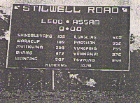 One of the items mentioned in First Overland, the story of the Cambridge-Oxford expedition to drive from London to Singapore that I just finished reading, is that the so-called Burma Road (also known as the Stillwell Road, after General Joseph Stillwell), which was built during World War II to connect Ledo in Assam, India, to Kunming, China, cost the U.S.A. $137 million to build.
One of the items mentioned in First Overland, the story of the Cambridge-Oxford expedition to drive from London to Singapore that I just finished reading, is that the so-called Burma Road (also known as the Stillwell Road, after General Joseph Stillwell), which was built during World War II to connect Ledo in Assam, India, to Kunming, China, cost the U.S.A. $137 million to build.
I was curious to know how much this would be “in today’s dollars,” which led to a further curiousity about how “in today’s dollars” amounts are calculated.
I sent this question in to the IsleAsk service and received a very helpful reply from Brenda Brady at the Holland College Library with some pointers to relevant websites:
- Current Value of Old Money from the University of Exeter.
- How Much Is That? from the Economic History Association.
- The Value of Money from Suburban Library System in Burr Ridge, IL.
What one learns from these and other websites is that, to quote Brenda, “determining the relative change in the value of money is not as simple as it looks, and can depend on context, changing technologies, changes in supply and demand, etc.”
That said, using the calculator on the How Much Is That? site, the $137 million figure comes out to anywhere from $1.5 billion (using the Consumer Price Index) to $2.3 billion (using the unskilled wage) to $4.2 billion (using the Gross Domestic Product per capita).
Calculated using any of these methods, it’s still one heck of a lot of money for a 1,079 mile road: even in 1942 dollars it was more than $125,000 per mile. Although, of course, not as much as our Confederation Bridge. But they had to go over water.
If you haven’t tried IsleAsk, I would encourage you to do so: it’s an easy way to get high quality reference information, from local sources, at no cost.

Comments
Great piece…
By the way my friend Jennie Levine, i.e. the Shifted Librarian is a star on the staff of the Burr Ridge Library.
I was even more surprised when I discovered how hard people find it to say _when_ historic things happened, even when your favorite monk or playwright thought to note the date (18 Brumaire?) If it weren’t for comets and eclipses (and more recently the telephone), I expect different cultural histories and epochs would be utterly unalignable.